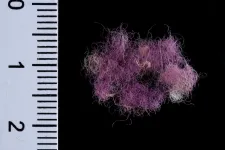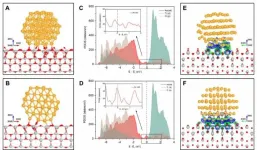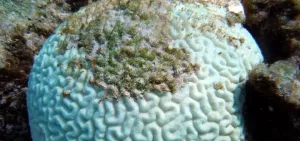From heat to spin to electricity: Understanding spin transport in thermoelectric devices
Scientists shed light on how the magnetic properties of 2D interlayers can enhance spin accumulation effects in thermoelectric heterostructures
2021-01-28
(Press-News.org) Thermoelectric materials, which can generate an electric voltage in the presence of a temperature difference, are currently an area of intense research; thermoelectric energy harvesting technology is among our best shots at greatly reducing the use of fossil fuels and helping prevent a worldwide energy crisis. However, there are various types of thermoelectric mechanisms, some of which are less understood despite recent efforts. A recent study from scientists in Korea aims to fill one such gap in knowledge. Read on to understand how!
One of these mechanisms mentioned earlier is the spin Seebeck effect (SSE), which was discovered in 2008 by a research team led by Professor Eiji Saitoh from Tokyo University, Japan. The SSE is a phenomenon in which a temperature difference between a nonmagnetic and a ferromagnetic material creates a flow of spins. For thermoelectric energy harvesting purposes, the inverse SSE is especially important. In certain heterostructures, such as yttrium iron garnet--platinum (YIG/Pt), the spin flow generated by a temperature difference is transformed into a current with an electric charge, offering a way to generate electricity from the inverse SSE.
Because this spin-to-charge conversion is relatively inefficient in most known materials, researchers have tried inserting an atomically thin layer of molybdenum disulfide (MoS2) between the YIG and Pt layers. Though this approach has resulted in enhanced conversion, the underlying mechanisms behind the role of the 2D MoS2 layer in spin transport remains elusive.
To tackle this knowledge gap, Professor Sang-Kwon Lee of the Department of Physics at Chung-Ang University, Korea, has recently led an in-depth study on the topic, which has been published in Nano Letters. Various colleagues from Chung-Ang University participated, as well as Professor Saitoh, in an effort to understand the effect of 2D MoS2 on the thermoelectric power of YIG/Pt.
To this end, the scientists prepared two YIG/MoS2/Pt samples with different morphologies in the MoS2 layer, as well as a reference sample without MoS2 altogether. They prepared a measurement platform in which a temperature gradient can be enforced, a magnetic field applied, and the voltage difference caused by the ensuing spin flow monitored. Interestingly, they found that the inverse SSE, and in turn the thermoelectric performance of the whole heterostructure, can be either enhanced or diminished depending on the size and type of MoS2 used. In particular, using a holey MoS2 multilayer between the YIG and Pt layers yielded a 60% increase in thermoelectric power compared with YIG/Pt alone.
Through careful theoretical and experimental analyses, the scientists determined that this marked increase was caused by the promotion of two independent quantum phenomena that, together, account for the total inverse SSE. These are called the inverse spin Hall effect, and the inverse Rashba-Edelstein effect, which both produce a spin accumulation that is then converted into a charge current. Moreover, they investigated how the holes and defects in the MoS2 layer altered the magnetic properties of the heterostructure, leading to a favorable enhancement of the thermoelectric effect. Excited about the results, Lee remarks: "Our study is the first to prove that the magnetic properties of the interfacial layer cause spin fluctuations at the interface and ultimately increase spin accumulation, leading to a higher voltage and thermopower from the inverse SSE."
The results of this work represent a crucial piece in the puzzle of thermoelectric materials technology and could soon have real-world implications, as Lee explains: "Our findings reveal important opportunities for large-area thermoelectric energy harvesters with intermediate layers in the YIG/Pt system. They also provide essential information to understand the physics of the combined Rashba-Edelstein effect and SSE in spin transport." He adds that their SSE measurement platform could be of great help to investigate other types of quantum transport phenomena, such as the valley-driven Hall and Nernst effects.
Let us hope that thermoelectric technology progresses rapidly so that we can make our dreams of a more ecofriendly society a reality!
INFORMATION:
About Chung-Ang University
Chung-Ang University is a private comprehensive research university located in Seoul, South Korea. It was started as a kindergarten in 1918 and attained university status in 1953. It is fully accredited by the Ministry of Education of Korea. Chung-Ang University conducts research activities under the slogan of "Justice and Truth." Its new vision for completing 100 years is "The Global Creative Leader." Chung-Ang University offers undergraduate, postgraduate, and doctoral programs, which encompass a law school, management program, and medical school; it has 16 undergraduate and graduate schools each. Chung-Ang University's culture and arts programs are considered the best in Korea.
Website: https://neweng.cau.ac.kr/index.do
About Professor Sang-Kwon Lee
Dr. Sang-Kwon Lee obtained a PhD in Electronic Engineering from the Royal Institute of Technology, Sweden, in 2002. He was then first appointed Assistant Professor in the Department of Semiconductor Science and Technology at Chonbuk National University, Korea, in 2002 and subsequently joined the Department of Physics at Chung-Ang University in 2013 as a Professor. He is currently in charge of teaching Modern Physics and Mathematical Physics at Chung-Ang University. His research interests mainly revolve around solid state physics, such as the development and modelling of nanoscale thermoelectric materials and devices. He works on nanobiotechnology--such as nanobiological semiconducting sensors and cancer cell characterization through devices such as nanowires--microfluidics, and microelectromechanical systems. Currently, he is also interested in working on valley-related effects, such as the valley-Nernst effect, valley-Hall effect and various new Seebeck effects for energy harvesting applications in his quantum transport research lab at Chung-Ang University. He has over 140 publications to his name.
[Attachments] See images for this press release:

ELSE PRESS RELEASES FROM THIS DATE:
2021-01-28
DALLAS - Jan. 28, 2021 - Simulation can be a viable way to quickly evaluate and refine new medical guidelines and educate hospital staff in new procedures, a recent study from UT Southwestern's Department of Pediatrics shows. The findings, published recently in the journal Pediatric Quality and Safety and originally shaped around new COVID-19-related pediatric resuscitation procedures at UTSW and Children's Health, could eventually be used to help implement other types of guidelines at medical centers nationwide.
For decades, U.S. hospitals have used the same standard procedures ...
2021-01-28
"King Solomon made for himself the carriage; he made it of wood from Lebanon. Its posts he made of silver, its base of gold. Its seat was upholstered with purple, its interior inlaid with love." (Song of Songs 3:9-10)
For the first time, rare evidence has been found of fabric dyed with royal purple dating from the time of King David and King Solomon.
While examining the colored textiles from Timna Valley - an ancient copper production district in southern Israel - in a study that has lasted several years, the researchers were surprised to find remnants of woven fabric, a tassel and fibers of wool dyed with royal purple. Direct radiocarbon ...
2021-01-28
(For Immediate Release--Singapore--January 28, 2021)-- In the phase II CodeBreak 100 trial, sotorasib provided durable clinical benefit with a favorable safety profile in patients with pretreated non-small cell lung cancer (NSCLC) and who harbor KRAS p.G12C mutations, validating CodeBreak 100's phase I results, according to research presented today at the International Association for the Study of Lung Cancer World Conference on Lung Cancer.
Outcome in patients with advanced NSCLC on second- or third-line therapies is poor, with a response rate of less than 20% and median progression-free survival of fewer than four months. Approximately 13% of patients with lung adenocarcinomas harbor KRAS p.G12C mutations.
Sotorasib is a first-in-class small molecule that specifically ...
2021-01-28
An international joint research team from the Shanghai Advanced Research Institute of the Chinese Academy of Sciences, along with Zhejiang University and the Technical University of Denmark, reported an in-situ strategy to manipulate interfacial structure with atomic precision during catalytic reactions. Results were published in the latest issue of Science.
The interface between nanoparticles and substrates plays a critical role in heterogeneous catalysis because most active sites are located at the perimeter of the interface. It is generally believed that this interface is immobile and unchangeable, thus can hardly be adjusted in reactive environments. As a result, it has been challenging to promote catalytic activity through precise control of the interfacial ...
2021-01-28
The emergence of SARS-CoV-2 virus variants that are adding twists in the battle against COVID-19 highlight the need for better genomic monitoring of the virus, says Katia Koelle, associate professor of biology at Emory University.
"Improved genomic surveillance of SARS-CoV-2 across states would really help us to better understand how the virus causing the pandemic is evolving and spreading in the United States," Koelle says. "More federal funding is needed, along with centralized standards for sample collection and genetic sequencing. Researchers need access to such metadata to better track how the virus is spreading geographically, and to identify any new variants ...
2021-01-28
BOSTON -- Routine screening of asymptomatic health care personnel (HCP) in the absence of confirmed exposures to COVID-19 is not a recommended strategy for preventing transmission of the coronavirus causing the current global pandemic, according to a new review co-authored by an infectious disease specialist at Massachusetts General Hospital (MGH). The review, published in Infection Control & Hospital Epidemiology, found that such testing is unlikely to affect the transmission of SARS-CoV-2 in health care settings and could even have unintended negative consequences.
Many universities, sports leagues and other institutions require individuals in their organization to undergo routine testing for COVID-19, whether or not they are experiencing symptoms. Current public ...
2021-01-28
When thick, the surface layer of the ocean acts as a buffer to extreme marine heating--but a new study from the University of Colorado Boulder shows this "mixed layer" is becoming shallower each year. The thinner it becomes, the easier it is to warm. The new work could explain recent extreme marine heatwaves, and point at a future of more frequent and destructive ocean warming events as global temperatures continue to climb.
"Marine heatwaves will be more intense and happen more often in the future," said Dillon Amaya, a CIRES Visiting Fellow and lead author on the study out ...
2021-01-28
Counties with a greater number of cannabis dispensary storefronts experience reduced numbers of opioid-related deaths relative to other locales, a recent University of California, Davis, study has found. This is the first study to examine the association between active cannabis dispensary operations -- both medical and recreational -- and opioid-related mortality rates at the county level, suggesting that providing alternative pain management could improve public health outcomes, researchers said.
"While the associations documented cannot be assumed to be causal, they suggest a potential relationship between increased prevalence of medical and recreational cannabis dispensaries and reduced opioid-related ...
2021-01-28
WASHINGTON --- Pancreatic cancer, one of the most lethal of all cancers, is capable of evading attacks by immune cells by changing its microenvironment so that the immune cells suppress, rather than support, an attack on the tumor. The scientists also found that that some of the mediators of this suppressive response, including a protein called STAT1, represent potential therapeutic targets that could be used to reverse this evasion and point to possible treatment opportunities.
The finding appears January 28, 2021, in Cancer Immunology Research.
"This ...
2021-01-28
The origin of flowering plants famously puzzled Charles Darwin, who described their sudden appearance in the fossil record from relatively recent geological times as an "abominable mystery". This mystery has further deepened with an inexplicable discrepancy between the relatively recent fossil record and a much older time of origin of flowering plants estimated using genome data.
Now a team of scientists from Switzerland, Sweden, the UK, and China may have solved the puzzle. Their results show flowering plants indeed originated in the Jurassic or earlier, that is millions of years earlier than their oldest undisputed fossil evidence, according to a new study published in the scientific journal Nature Ecology & Evolution. The lack of older ...
LAST 30 PRESS RELEASES:
[Press-News.org] From heat to spin to electricity: Understanding spin transport in thermoelectric devices
Scientists shed light on how the magnetic properties of 2D interlayers can enhance spin accumulation effects in thermoelectric heterostructures




